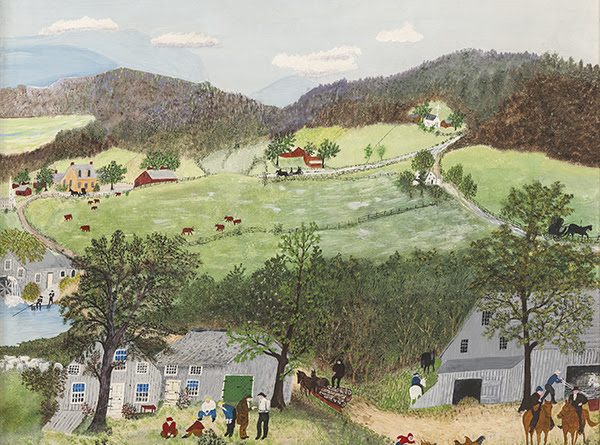SAAM’s New “Grandma Moses” Exhibit Explores Creativity, Labor & Legacy
Now on view at the Smithsonian American Art Museum, Grandma Moses: A Good Day’s Work is a major new exhibition that offers a fresh perspective on the life and art of Anna Mary Robertson “Grandma” Moses.
Spanning over 80 paintings, photographs, and personal objects, this retrospective repositions Moses not just as a beloved figure in American folk art, but as a multidimensional artist whose works were deeply entwined with the rhythms of labor, memory, and creative fulfillment.
Anchored by key works from the museum’s extensive collection, A Good Day’s Work presents 88 pieces by Moses, many of which were created in the latter part of her life, when she began painting in her late 70s.
The exhibition explores how Moses’ art intersected with her life as a farmer, wife, and mother, capturing both the simplicity and complexity of rural American life during a time of seismic change. The exhibit traces the evolution of Moses’ artistic practice — from her early days in the Shenandoah Valley to her rise as a global folk art icon.
The exhibition takes its title from a phrase that Moses herself used to describe her daily routine: a good day’s work.
Born in 1860 in Greenwich, New York, Moses spent her early years on a farm, where she honed her creativity by drawing with berry juices on scraps of newsprint. Yet it wasn’t until her husband’s death and the departure of her children that Moses found the time and space to take up painting seriously, at the age of 78.
The exhibition explores Moses’ life through the lens of her dual roles as a laborer and an artist. In particular, the exhibit examines how her creative work became an extension of her previous life in agriculture, where routine and hard work were essential. As Leslie Umberger, the exhibition’s curator, notes, Moses’ artmaking “displaced the hours once dedicated to family and farming,” signaling a personal transformation from farmwife to internationally recognized artist.
The show also delves into lesser-known periods of Moses’ life, including her years spent in post-Reconstruction Virginia, where she and her husband ran a successful dairy farm.
Moses was thrust into the spotlight in 1939 after a local collector purchased a series of her paintings, sparking interest from art dealer Otto Kallir. Within two years, she had her first solo exhibition, which marked the beginning of her celebrity. After World War II, Moses became synonymous with a simpler, idealized vision of American life, an image that resonated with a nation recovering from war and grappling with rapid social and political change. Her paintings of rural life and holiday scenes, often infused with personal memories and local lore, struck a chord with the American public, earning her a place in the broader cultural imagination.
Her fame grew quickly. By the late 1940s, Hallmark had licensed her images for greeting cards, and reproductions of her work appeared on fabrics, china, and other consumer goods. Moses became a household name, even earning an Academy Award-nominated documentary in 1950. In this exhibition, visitors will encounter the full arc of Moses’ rise to fame, including photographs, ephemera, and excerpts from her own autobiography, which provide valuable insight into the woman behind the art.
Grandma Moses: A Good Day’s Work will be on view from October 24, 2025, through July 12, 2026.

